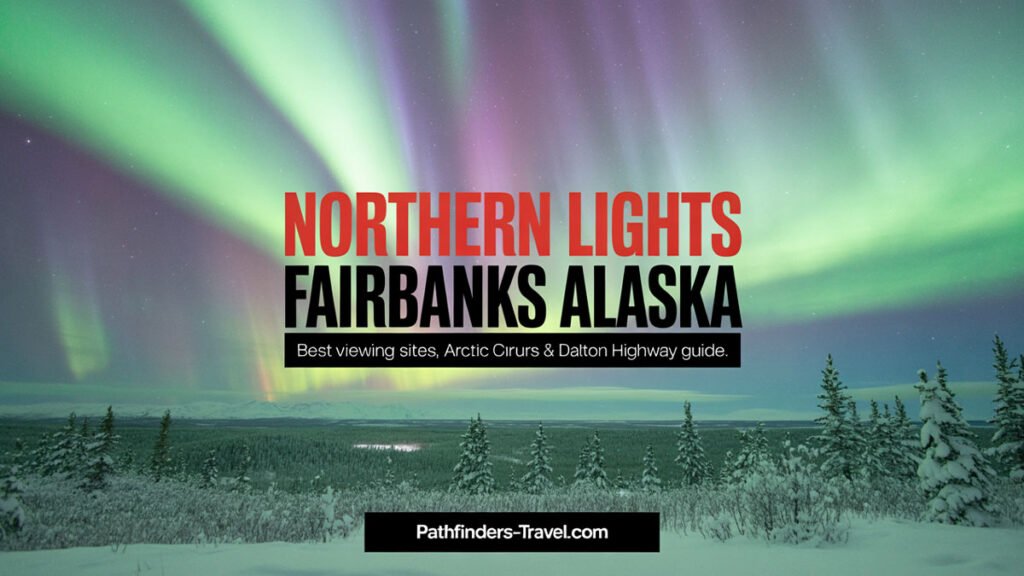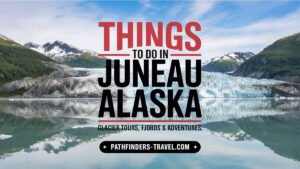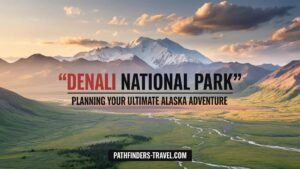Estimated reading time: 19 minutes
Last Modified Date: 10/10/2025
Key Takeaways
- Fairbanks serves as the gateway to the Arctic and offers exceptional northern lights viewing opportunities from late August to April.
- Chena Hot Springs Resort offers natural geothermal pools at 106°F year-round, with perfect conditions for aurora viewing in winter.
- Fairbanks experiences dramatic seasonal contrasts – nearly 22 hours of daylight in summer and long winter nights perfect for northern lights.
- The Dalton Highway provides a 414-mile adventure through Alaska’s untamed wilderness to the Arctic Ocean.
- Arctic Circle tours from Fairbanks offer day and overnight journeys to experience the unique landscapes and wildlife of Alaska’s far north.
- Yukon River experiences provide opportunities for river tours, wildlife watching, and connecting with Alaska’s rich history.
Table of Contents
- Introduction
- Fairbanks: The Heart of Alaska’s Arctic Experience
- Relax and Rejuvenate at Chena Hot Springs Resort
- Adventures Beyond Fairbanks: Arctic Circle Tours
- Driving the Dalton Highway: Journey Through Alaska’s Untamed Wilderness
- Experiencing the Yukon River
- Frequently Asked Questions about Fairbanks & Arctic Circle
- Conclusion
Introduction
Welcome to Alaska’s vast interior, a land defined by its extreme and diverse landscapes spanning boreal forests, tundra, winding rivers, and rugged mountains. This remote region experiences some of the most dramatic seasonal swings on the planet – from summer’s constant daylight that bathes the land in nearly 24 hours of sunshine to winter’s long, dark nights that create perfect conditions for northern lights viewing in Fairbanks. At the heart of this wilderness sits Fairbanks, the gateway to the Arctic and your starting point for exploring the raw beauty of Alaska’s interior. Whether you’re seeking the magical dance of the aurora borealis or looking for the best things to do in Fairbanks throughout the year, this guide will take you through the most rewarding experiences in Alaska’s northern frontier.
If you want to enjoy the stunning natural wonders in Faibanks and other places in Alaska, click here to watch the travel documentary in UHD 4K Resolution.
Fairbanks & the Auroral Zone: Seasonal Contrast and Northern Lights
Seasonal Contrasts: Best Things to Do in Fairbanks Year-Round
Fairbanks presents two dramatically different faces throughout the year, each offering its own unique set of experiences. During summer months, this northern city bathes in nearly 22 hours of daylight, creating the phenomenon known as the midnight sun. This extended daylight makes late-night fishing trips, evening hikes, and midnight festivals not just possible but common local activities. The abundant sunshine transforms the surrounding forests and fields into lush green landscapes teeming with wildlife and wildflowers.
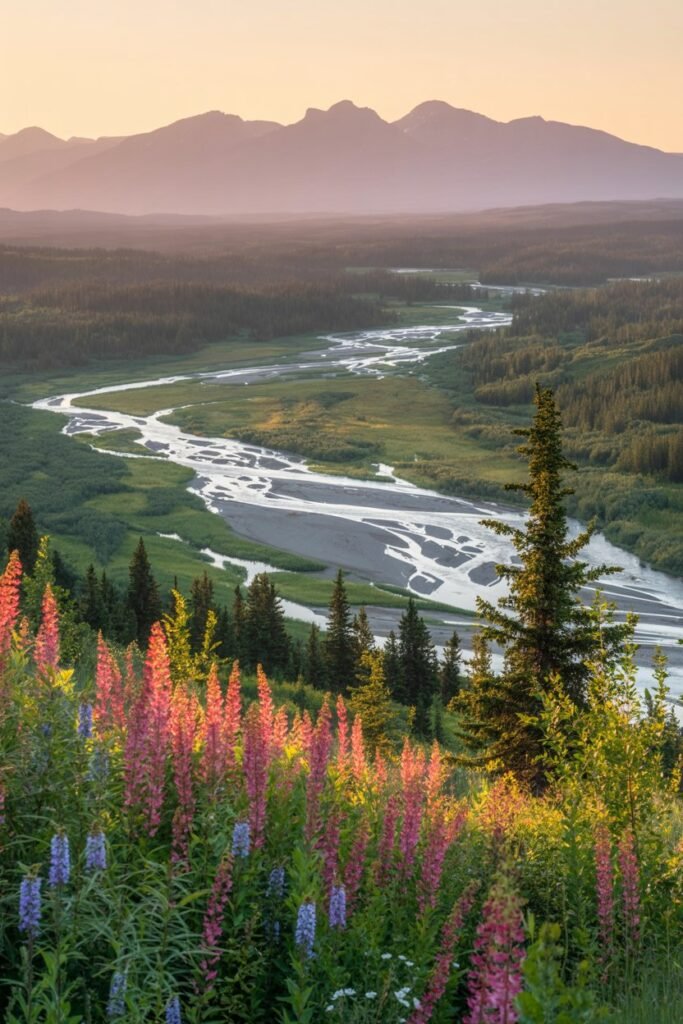
When winter arrives (September through April), Fairbanks undergoes a complete transformation. The long dark nights bring temperatures that can drop well below zero, but they also deliver perfect conditions for dog mushing adventures, winter festivals, and most famously, vivid northern lights viewing opportunities. The stark beauty of snow-covered forests and mountains creates a winter wonderland that attracts travelers seeking authentic Arctic experiences.
Northern Lights Viewing Fairbanks: Top Aurora Experiences
Fairbanks has earned its reputation as one of the world’s best locations to witness the aurora borealis. The city’s position under the “auroral oval” (the ring-shaped area around the North Pole) creates ideal viewing conditions from late August through April. The combination of clear nights, low humidity, and minimal light pollution makes Fairbanks a prime destination for aurora chasers [SOURCE].
For those hoping to catch this natural light show, guided aurora tours offer the best chances of success. Many local operators provide tours that combine northern lights viewing with other experiences such as soaking in hot springs, overnight stays at remote lodges, or photography workshops. These guides know the best spots away from city lights and can track aurora forecasts to maximize viewing opportunities.
If you’re visiting during aurora viewing season, plan to stay at least three nights to increase your chances of clear skies and active auroras. The lights typically appear between 10 PM and 2 AM, though they can happen any time during the dark hours.
Local Attractions & Culture
Beyond its natural wonders, Fairbanks offers rich cultural experiences and interesting attractions that showcase Alaska’s heritage. The University of Alaska Museum of the North houses impressive exhibits on Alaska Native cultures, natural history, and even features aurora recreations that help visitors understand this scientific phenomenon. Car enthusiasts will appreciate the Fountainhead Antique Auto Museum, which displays an impressive collection of vintage automobiles alongside period fashion.
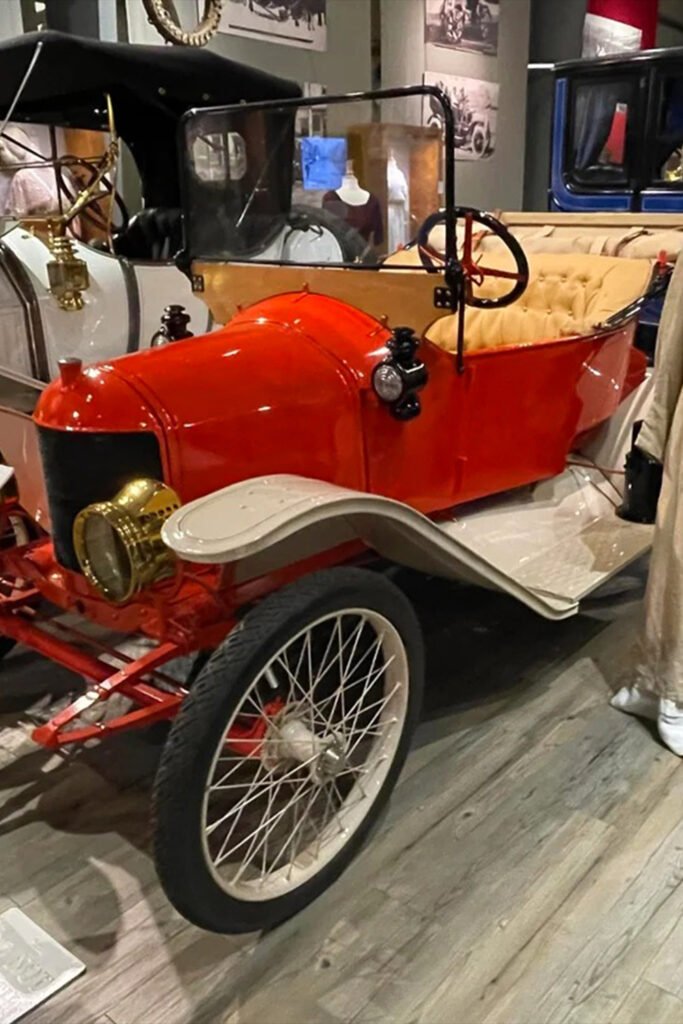
The Morris Thompson Cultural & Visitors Center provides an excellent introduction to the region with free exhibits focusing on Alaska Native heritage and local crafts. This center also serves as a practical hub for trip planning with staff who can provide up-to-date information on road conditions, weather forecasts, and local events [SOURCE].
Throughout the year, festivals and events celebrate the unique culture of interior Alaska. The World Eskimo-Indian Olympics showcases traditional Native games and competitions that have been practiced for centuries. The Midnight Sun Festival marks the summer solstice with a street fair, live music, and food vendors operating under the bright midnight sun. Winter brings the World Ice Art Championships, where sculptors transform blocks of ice into dazzling works of art.
Outdoor enthusiasts can enjoy a wide range of activities, including dog mushing with local mushers, snowmobiling across frozen lakes and trails, and wildlife viewing tours that offer chances to spot moose, foxes, and various bird species [SOURCE].
Chena Hot Springs Resort: Hot Springs, Tours & Aurora Viewing
Geothermal Pools & Amenities at Chena Hot Springs Resort
Just 60 miles northeast of Fairbanks lies Chena Hot Springs Resort, a year-round destination featuring natural hot springs that have attracted visitors for over 100 years. The resort’s main attraction is its outdoor Rock Lake, a natural-looking rock-lined pool where mineral-rich waters maintain a constant temperature of around 106°F (41°C) regardless of the outside weather [SOURCE].
The hot springs operate on a “flow-through” system, meaning the water constantly refreshes and drains multiple times daily, ensuring a clean, mineral-rich soaking experience. The outdoor Rock Lake is reserved for adults only (18+), while families with children can enjoy the indoor pools and hot tubs located in the resort’s Activity Center [SOURCE].
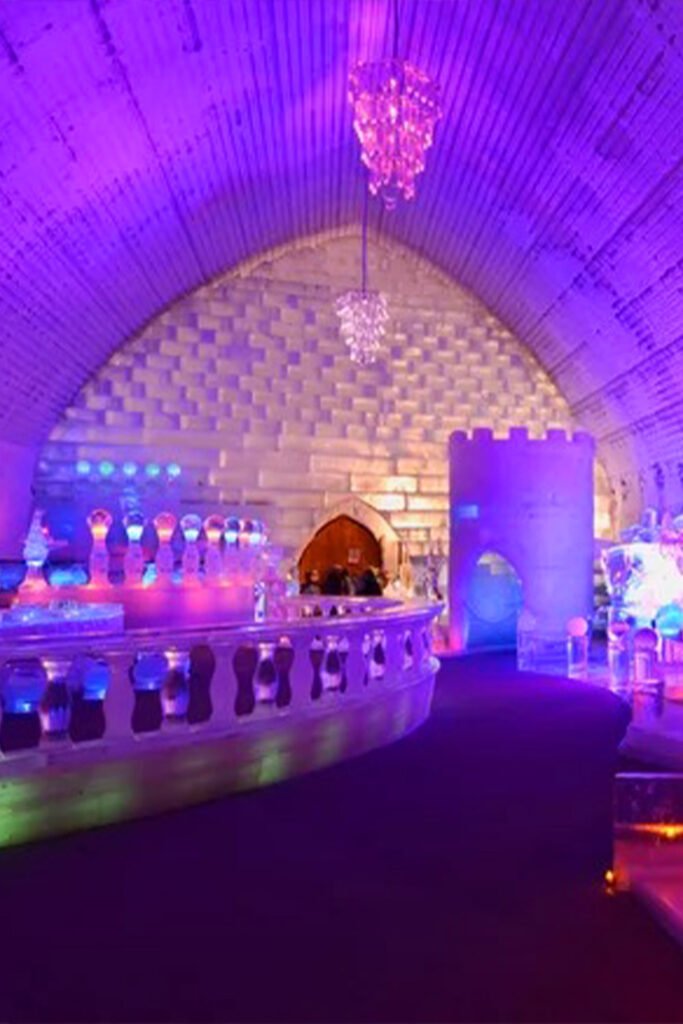
Beyond the hot springs, the resort offers several unique amenities. The Aurora Ice Museum, crafted from over 1,000 tons of ice and snow, showcases impressive ice sculptures and offers ice cocktail glasses at its ice bar. Visitors can also book massage services at the resort’s spa, enjoy meals at the restaurant featuring locally-grown ingredients from the resort’s greenhouses, or take a guided tour of the geothermal energy system that powers much of the resort [SOURCE].
Aurora Viewing
Chena Hot Springs Resort has become famous as one of Alaska’s premier spots for northern lights viewing. The resort’s location far from city lights creates exceptionally dark skies, perfect for observing the dancing auroras overhead. The experience of watching the northern lights while soaking in steaming hot springs is truly magical and draws visitors from around the world [SOURCE].
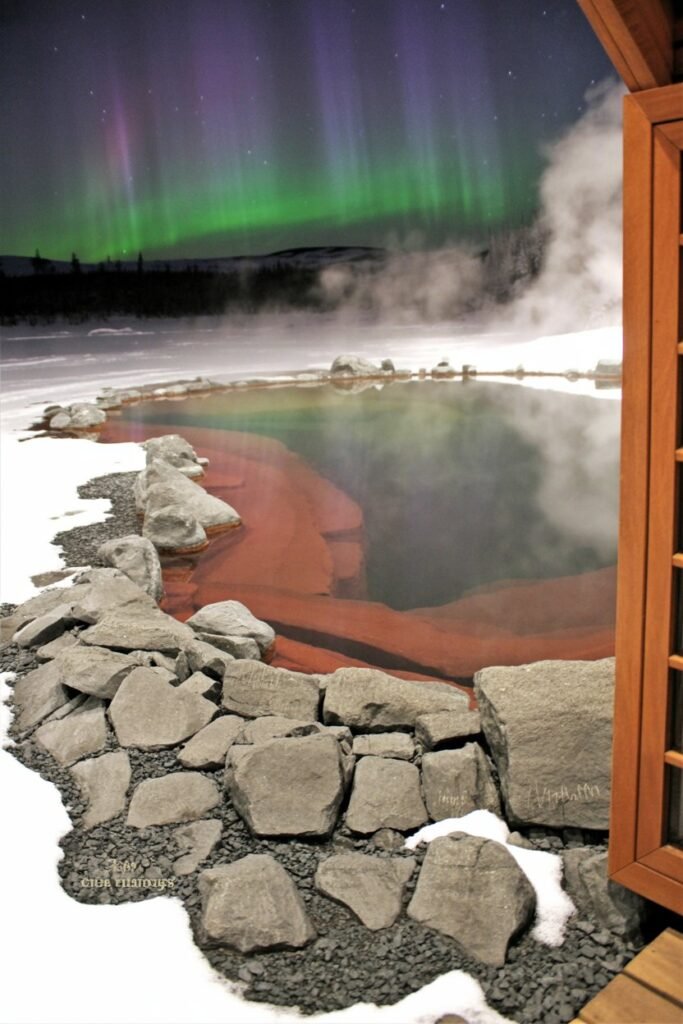
For serious aurora watchers, the resort offers Aurora Tours that transport guests to an even darker viewing location atop a nearby ridge. Here, a heated yurt provides shelter while visitors wait for the lights to appear. The resort’s staff keeps track of aurora forecasts and can alert guests when activity is expected, maximizing chances for a successful viewing experience.
Many visitors find that combining hot springs with aurora watching creates the perfect winter activity – you can stay warm in the steaming waters while gazing up at the night sky, making the cold temperatures much more bearable.
Practical Visitor Tips
If you’re planning a visit to Chena Hot Springs Resort, there are several practical tips to enhance your experience. Day passes are available for non-overnight guests who want to access the hot springs. These passes provide full access to the outdoor Rock Lake and indoor facilities.
Remember to bring your own towel or be prepared to rent one at an additional cost. The locker rooms are functional but often described as basic; locker use requires coins, so bring quarters if you plan to store your belongings securely [SOURCE].
When driving to the resort, especially in winter, exercise caution on the Chena Hot Springs Road. Wildlife such as moose frequently cross the road, particularly at dusk and dawn. In winter months, consider returning to Fairbanks before dark unless you’re staying overnight at the resort.
Regarding timing, the best time to visit depends on your interests. September through March offers the best aurora viewing opportunities, with December and January providing the darkest skies but also the coldest temperatures. Summer months (May through August) are ideal for hiking the surrounding trails, enjoying longer daylight hours, and more comfortable outdoor temperatures .
Arctic Circle Tours from Fairbanks: Routes, Highlights & Tips
Arctic Circle Tour from Fairbanks: Overview & Highlights
For travelers seeking a true northern adventure, Arctic Circle tours from Fairbanks offer an opportunity to cross into one of the world’s most remote and fascinating regions. These tours take you along the famous Dalton Highway, allowing you to officially cross the Arctic Circle at latitude 66°33′ North – a milestone achievement for any traveler [SOURCE].
Tour options typically include day trips and overnight journeys, each providing different experiences of the Arctic landscape. Transportation varies from comfortable vans and small buses to air tours that fly you over the vast wilderness, offering spectacular views impossible to capture from the ground. Day trips generally include a 12-14 hour round trip from Fairbanks with stops at key viewpoints, while overnight options allow for deeper exploration and better aurora viewing chances in winter.
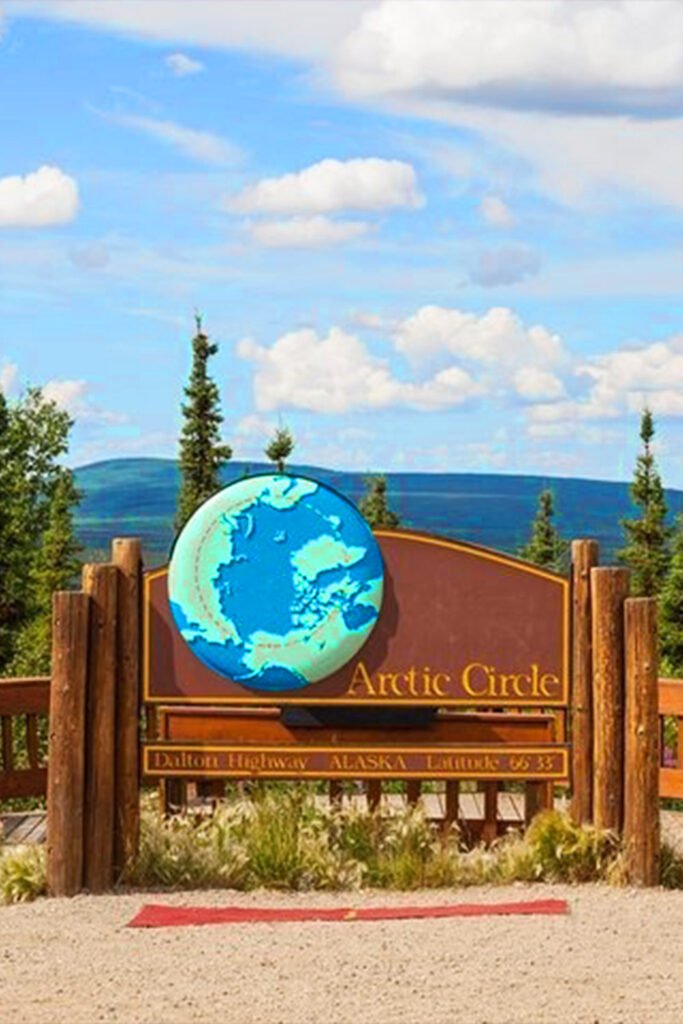
A highlight of these tours is the opportunity to stand at the Arctic Circle Monument, marking the imaginary line above which the sun doesn’t set during the summer solstice and doesn’t rise during the winter solstice. This creates the phenomenon of the midnight sun in summer and polar nights in winter, giving you a true taste of Arctic living.
Many Arctic tours also include visits to the tiny communities along the route, such as Coldfoot and Wiseman, where you can meet locals who have adapted to life in one of the world’s most challenging environments. These encounters provide fascinating insights into the unique lifestyle of Arctic residents.
Key Experiences
Arctic Circle tours offer several unforgettable experiences that highlight the unique character of Alaska’s far north. Wildlife viewing opportunities abound along the journey – keep your eyes peeled for moose browsing in thickets, caribou traversing the tundra, and various bird species adapted to the northern climate [SOURCE].
The landscape itself becomes an attraction as you travel northward. Watch as dense boreal forests gradually give way to open tundra, with the majestic Brooks Range mountains creating a dramatic backdrop. The changing terrain tells the story of Alaska’s ecological zones and how they shift with latitude and elevation.
Photography enthusiasts find Arctic Circle tours particularly rewarding. The quality of light in the Arctic is unlike anywhere else – with long, golden hours during summer and the soft, blue twilight of winter creating perfect conditions for landscape photography. In winter months, tours often include opportunities for aurora photography, with guides who can help you capture this natural phenomenon.
For those visiting in summer, experiencing the midnight sun is a highlight. Standing in the Arctic Circle while the sun circles the horizon without setting creates a surreal feeling that many travelers describe as life-changing. Conversely, winter visitors experience the opposite extreme with the brief, twilight days that barely brighten before fading back to darkness.
Driving the Dalton Highway: Route, Risks & Scenic Access
Driving the Dalton Highway: Route & Challenges
The Dalton Highway represents one of North America’s most epic road trips, stretching 414 miles from Fairbanks to Deadhorse near the Arctic Ocean. Built primarily as a supply route for the Trans-Alaska Pipeline, this rugged highway parallels the pipeline for much of its length, offering travelers a glimpse into both Alaska’s raw wilderness and its industrial presence [SOURCE].
The highway is predominantly gravel and dirt, with only portions paved. This creates a challenging driving environment with potholes, washboard surfaces, and occasional mud or dust depending on weather conditions. Traffic mainly consists of large trucks supplying the oil fields at Prudhoe Bay, which have the right of way and can kick up rocks and debris as they pass.
Services are extremely limited along the route. After leaving Fairbanks, there are only three places to get fuel: at the Yukon River (mile 56), Coldfoot (mile 175), and Deadhorse (mile 414). Cell phone coverage is virtually non-existent for most of the journey, making proper preparation essential for safety [SOURCE].
Weather presents another significant challenge. Conditions can change rapidly, with snowstorms possible even in summer at higher elevations. Winter travel is recommended only for those with extensive cold-weather experience, as temperatures can plummet to -40°F or lower.
Preparation & Safety Tips
Proper preparation is crucial for safely traveling the Dalton Highway. First and foremost, you’ll need a sturdy vehicle – preferably a 4WD/AWD with good clearance. Most rental car companies prohibit taking their vehicles on the Dalton, so specialized rental agencies in Fairbanks cater to Dalton Highway travelers with appropriately equipped vehicles.
Your vehicle should carry essential supplies: at least one full-sized spare tire (preferably two), a tire repair kit, jumper cables, extra food and water, warm clothing regardless of season, and emergency communication devices like a satellite phone or personal locator beacon. Carrying extra fuel is also recommended, as the distances between service stations can test your vehicle’s range.
Before departure, check road conditions with the Alaska Department of Transportation or at visitor centers in Fairbanks. Let someone know your itinerary and expected return date. Plan your driving to avoid traveling in darkness when possible, as wildlife is more active during dawn and dusk.
When encountering trucks or other vehicles, slow down and pull over to the right to allow them to pass safely. This reduces the chance of windshield damage from flying rocks. When stopping for photographs or breaks, pull completely off the road to ensure safety from passing traffic.
Scenery & Remote Stops
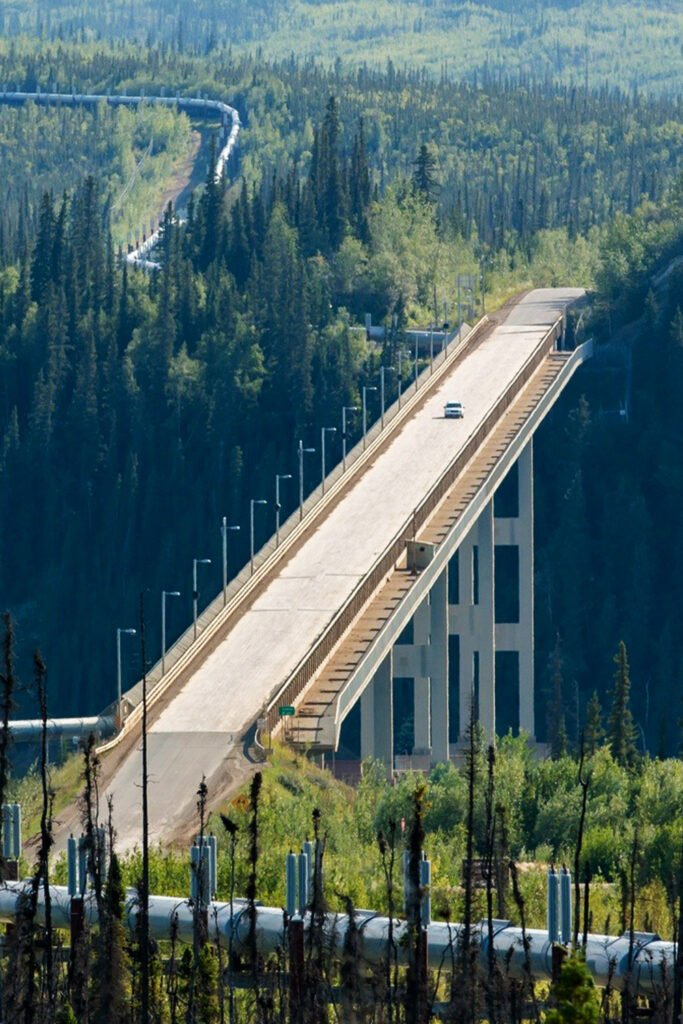
Despite its challenges, the Dalton Highway rewards travelers with some of Alaska’s most spectacular scenery. The journey begins in the boreal forests near Fairbanks before crossing the mighty Yukon River at mile 56, where a small service area provides the first opportunity for fuel, food, and basic accommodations [SOURCE].
Continuing north, you’ll cross the Arctic Circle at mile 115, marked by a sign that makes for a popular photo opportunity. The landscape gradually transitions from forest to open tundra as you approach the majestic Brooks Range, a mountain chain that forms the continental divide between the Arctic and Pacific watersheds.
Coldfoot, at mile 175, serves as the main service hub along the route, offering fuel, food, lodging, and the Arctic Interagency Visitor Center where you can learn about the natural and cultural history of the region. Just north of Coldfoot, the tiny community of Wiseman provides a glimpse into rural Alaskan life above the Arctic Circle [SOURCE].
The highway’s most dramatic scenery unfolds as you traverse Atigun Pass (elevation 4,800 feet), where the road winds through the heart of the Brooks Range. Beyond the pass, the landscape opens into the vast North Slope, a treeless tundra stretching to the Arctic Ocean. During summer, this area erupts with wildflowers and teeming bird life, while winter transforms it into a stark, snow-covered expanse.
Visiting the Yukon River: Tours, Wildlife & History
Visiting the Yukon River: Must-Do Adventure & Tours
No exploration of Alaska’s interior is complete without experiencing the mighty Yukon River, North America’s third-longest river and a lifeline through the heart of Alaska. This powerful waterway has shaped the region’s history, serving as a highway for indigenous peoples, gold rush prospectors, and modern adventurers alike [SOURCE].
From Fairbanks, visitors can access the Yukon at several points, with the Dalton Highway crossing at the Yukon River Bridge offering one of the most convenient access points. Here, you can walk along the shoreline, take photographs of the massive river, or even dip your toes in its cold waters during summer months.
For a more immersive experience, river tours operate during the ice-free months (typically May through September), ranging from short sightseeing excursions to multi-day adventures. These tours provide opportunities to see the river from its best vantage point – on the water itself – while guides share stories about the river’s natural and human history [SOURCE].
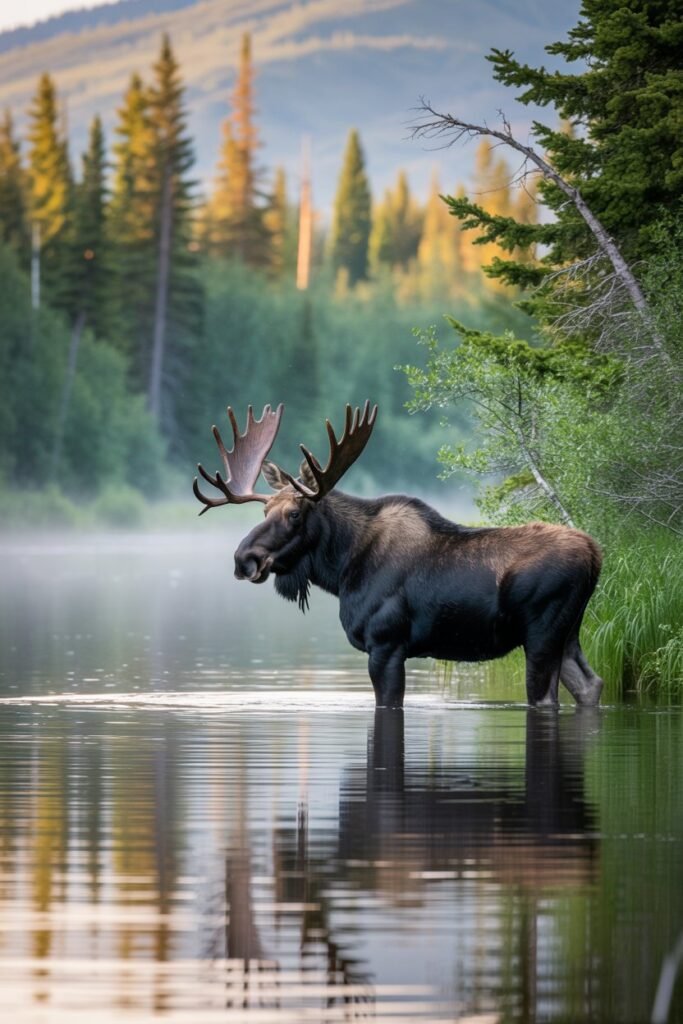
Wildlife watching along the Yukon offers excellent opportunities to spot species adapted to the northern environment. Bald eagles perch in tall trees overlooking the water, moose often wade near the shorelines, and bears may be seen fishing or foraging along the banks. The river corridor serves as an important habitat and migration route for numerous bird species, making it a paradise for birdwatchers.
Connection to Alaskan Adventure
The Yukon River holds a special place in Alaska’s story, connecting the past to the present through its waters. For thousands of years, Alaska Native communities lived along its banks, relying on the river for transportation, food, and as a central element in their cultural traditions.
During the Klondike Gold Rush of the late 1890s, thousands of hopeful prospectors navigated the Yukon’s waters in search of fortune, establishing settlements that would grow into today’s communities. The remnants of this era can still be seen at various points along the river, with abandoned cabins and mining equipment telling the story of this transformative period.
Today, the Yukon continues to serve as a vital transportation corridor for communities not connected to the road system. In winter, sections of the frozen river become ice roads, providing access to isolated villages. In summer, boats carry supplies, mail, and travelers between remote locations.
Experiencing the Yukon River connects visitors to this rich Alaskan heritage while showcasing the raw power and beauty of nature. Whether you’re standing on its banks, floating on its current, or learning about its significance to the people who have lived along it for generations, the Yukon River exemplifies Alaska’s wild character and historic importance.
Frequently Asked Questions about Fairbanks & the Arctic Circle
When is the best season or month to visit Fairbanks for northern lights viewing?
The prime season for aurora viewing in Fairbanks runs from late August through April, when nights are long and dark and solar activity is at its peak. September through March often provide the best combination of clear skies and extended darkness. March is particularly active due to the spring equinox. Plan for at least three nights to improve your viewing chances.
What safety precautions should I take when driving the Dalton Highway through Alaska’s remote zone?
Driving the Dalton Highway is a demanding experience. Use a 4WD/AWD vehicle (many rentals restrict this route), bring two spare tires, tools, emergency gear, extra fuel, and enough food and water for remote stretches. Mobile service is almost nonexistent, and towing can cost thousands of dollars. Always check weather and road reports before departure and aim to drive in daylight.
How should I plan an Arctic Circle tour from Fairbanks to maximize experiences?
Arctic Circle tours from Fairbanks generally take 12–14 hours as day trips or include overnight stays for deeper exploration. Options range from overland bus journeys to scenic flights. Itineraries often feature the Arctic Circle Monument, stops along the Dalton Highway, and small communities such as Coldfoot or Wiseman. Choose operators with safety gear, aurora tracking, and flexible scheduling.
What gear should I pack for winter nights in Interior Alaska for aurora and road travel?
Pack in layers designed for Arctic temperatures: thermal basewear, insulating fleece or wool, and a down or synthetic parka. Add waterproof boots, gloves, a hat, and a face covering. Bring hand and foot warmers, extra batteries, a headlamp, and a tripod if photographing auroras. For self-drive trips, carry emergency supplies such as a repair kit, first aid, and a satellite communicator.
Can I reach the Arctic Ocean independently via the Dalton Highway?
Independent access to the Arctic Ocean is not allowed beyond Deadhorse. Travelers must join an authorized guided tour to reach the coastline. The Dalton Highway itself is open to public travel where permitted, but visiting the ocean requires pre-arranged security clearance through licensed operators.
Conclusion
From the aurora-filled skies over Fairbanks to the geothermal calm of Chena Hot Springs Resort and the wild expanse of the Dalton Highway, interior Alaska captures the essence of adventure and solitude. Each destination offers a different rhythm of the north—quiet, expansive, and deeply tied to the land.
Traveling through these regions connects visitors not only to extraordinary scenery but also to Alaska’s enduring human spirit. Local guides and residents bring the Arctic’s stories to life, offering a perspective that blends resilience with reverence for nature.
Before setting out, plan with the season in mind—long daylight in summer for exploration, or endless night in winter for the aurora. Pair your journey with nearby regions such as Denali National Park to experience Alaska’s varied landscapes within one itinerary.
Whether you’re crossing the Arctic Circle, tracing the Yukon River, or simply watching the northern lights from a quiet ridge, Alaska’s interior leaves travelers with a lasting sense of wonder and scale found nowhere else on Earth.
Whether you visit during the endless daylight of summer or the aurora-filled skies of winter, Alaska’s interior promises memories that will stay with you long after you’ve returned home. For more stunning views of Alaska and other natural wonders, be sure to visit Pathfinders Travel YouTube channel to watch their travel documentaries in stunning 4K resolution.

